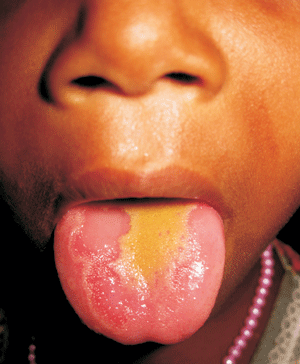|
|
|
Indian Pediatr 2013;50: 1178 |
 |
Benign Migratory Glossitis
|
|
Dhiraj Kumar, Anupam Das and Ramesh Chandra Gharami
Department of Dermatology,
Medical College and Hospital, Kolkata,
West Bengal, India.
Email: anupamdasdr@gmail.com
|
A 9-year-old girl presented with complaints of burning
sensation particularly with hot and spicy foods, and white
lesion over tongue since 15 days. Review of her medical
history revealed that she had similar complaints in the past
which wane off without significant morbidity. She appeared
normal, healthy, and well-developed. There were no abnormal
extraoral clinical findings. Intraoral examination revealed
a good oral hygiene, and no evidence of inflammation. The
dorsum of tongue revealed irregular, circumscribed
erythematous areas devoid of filiform papilla (Fig.
1). The lesions had raised white margins that could not
be scraped off. These were surrounded a yellowish
hyperkeratotic lesion on the posterior aspect. Lesions were
migrating across the tongue by healing on one edge while
extending on another. The regions were non-tender, no
evidence of leukoplakia or white curd-like pseudomembranes.
Other systemic examination and serological investigations
were with in normal limit. On the basis of history and
clinical examination, provisional diagnosis of "benign
migratory glossitis" (BMG) was made. Histological
examination shows parakeratosis, acanthosis, dense
polymorpho-nuclear infilteration, with Munro abscess in the
epidermis. Exfoliative cytology was negative for Candida.
On clinical and histopathological findings, diagnosis of
benign migratory glossitis was made and she has been
prescribed antihistamines and topical corticosteroid. Her
mother was counselled regarding the benign nature of the
disease.
 |
|
Fig. 1 Irregular,
circumscribed erythematous areas with yellowish
hyperkeratosis.
|
Benign migratory glossitis (BMG),
(geographic tongue, erythema migrans, annulus migrans and
wandering rash of the tongue) is uncommon and occurs in up
to 2% of the population. The exact cause is unknown but
association with HLA-B15 suggest role of heredity in
etiology of BMG. Attempts have been made to demonstrate an
association between various systemic and/or psychological
conditions and BMG but definitive causal relationship has
not been established yet. BMG is characterized by
irregularly shaped erythematous, map-like smooth swollen
patches bounded by slightly elevated keratotic band
occurring mostly on dorsum of tongue, extending onto the
lateral borders. The location and pattern undergo change
over time, thereby accounting for the name "migratory."
Differentials include candidiasis (white exudate resembling
cottage cheese along with a moist surface, growth of
Candida positive on culture), leukoplakia (homogeneous
or speckled white plaque that usually has sharply demarcated
borders), psoriasis (usually associated with typical
cutaneous lesions) and drug reaction. It is a benign
condition that usually resolves itself without causing any
problem. Discomfort may be treated with an antihistaminic,
mouth gargle or rinse containing antiseptic and anaesthetic
agents and topical corticosteroids.
|
|
|
 |
|

